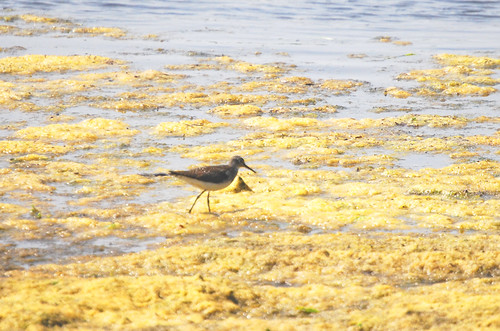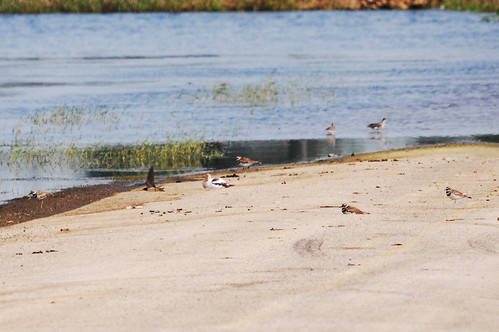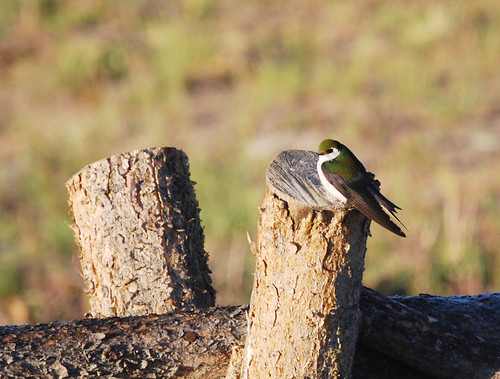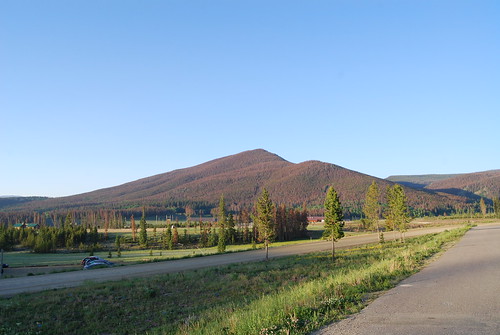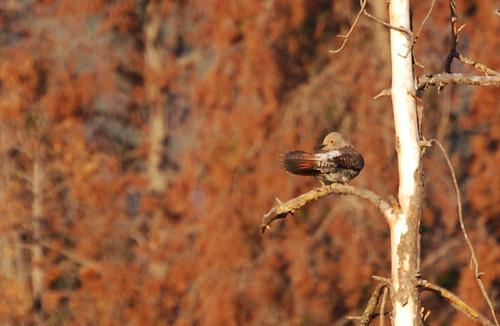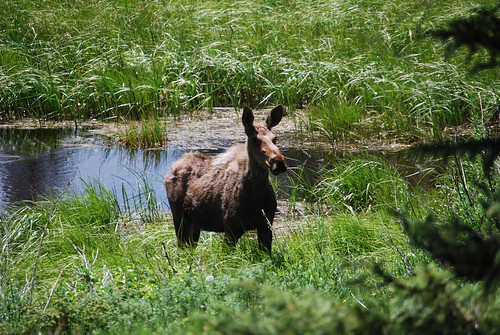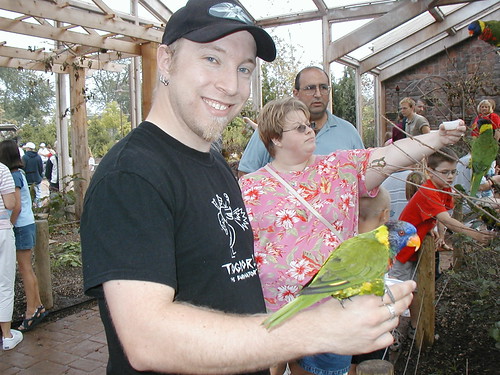Thursday, July 31, 2008
Shaping up to be a poor shorebird season
I went out last Sunday with some friends to check out shorebird habitat in the NW corner of the state. While we found some pretty good birds, the amount of habitat was pretty sparse. Everything has either too much water or not enough, it seems. A lot of traditional great areas look like total busts, such as Medusa Marsh (too much water), Pipe Creek (not enough water) and Pickerel Creek (ditto). One exception is the Bellevue area south of Sandusky, which had suffered some severe flooding earlier in the summer.
Due to a quirk of local geology, the flood waters around Bellevue are taking a very long time to recede, so long in fact that the flooded fields served to host dozens of breeding Pied-billed Grebes and ducks. More interestingly, a group of four Black-necked Stilts showed up there in June and attempted to nest, although it seems the attempt failed. We saw the stilts, along with an American Avocet, a raft of Ruddy Ducks, Solitary Sandpipers, Semipalmated Sandpipers, Least Sandpipers, Pectoral Sandpipers, Greater and Lesser Yellowlegs, Killdeer, Semipalmated Plover, and Short-billed Dowitcher.
I also found out I'm getting to go to Tucson for a work conference at the end of September. I've already scheduled in two or three days to go birding!
Monday, July 21, 2008
Goodbye, nemesis bird!
So, I'm now four species away from 300 in Ohio and three species away from 400 ABA birds. The next couple of months will be interesting to see what might fill in the last slots before those milestones. I may actually hit 400 ABA before 300 Ohio birds, as I am probably headed to Tuscon, Arizona in September for a conference ( and you know I'll be spending an extra day or two birding...).
Tuesday, July 15, 2008
Two new birds for my state list
Later that day, I also added Upland Sandpiper to my state list, ticking it off at the Harrison County Airport (where I also added Bobolink to my Ohio year list).
So now, I'm up to 293 species on my Ohio list. This weekend, I'm probably going out with a couple friends to the NW corner of the state, to see the Western Meadowlark and Clay-colored Sparrows up near Toledo. Both would be additions to my state list, and Clay-colored Sparrow would also be an ABA area bird for me. I'm trying to convince my buddies that we should hit a decent marsh for Marsh Wren - my Nemesis bird. I really don't want such a common bird to be a "milestone" bird -either Ohio #300 or ABA# 400!
Thursday, July 10, 2008
The Smithsonian Field Guide to the Birds of North America
Another interesting feature of the guide is the inclusion of a bird song DVD with vocalizations for 138 species, totaling 587 mp3 files. The files are intended for download onto a portable mp3 player, which I suppose is a sign of the ubiquity of these devices in birding culture (although I have yet to pick one up). While the inclusion of the DVD is a great idea, I do agree with other reviewers that it would have been more useful to include sound files for ALL of the species in the guide, at the sacrifice of the variety of vocalizations. The DVD includes many very common species, but there’s some weird omissions – Willow Flycatcher is included, but none of the other common Empidonax flycatchers that are virtually indistinguishable from Willow Flycatcher – except by voice! I think that while the idea is great, by not including an mp3 file for every bird in the book, the concept falls flat. It’s nice to have the short perch songs, dawn song, dawn flight song, and calls from two different regions for Tree Swallow, but the limited number of species on the disc just makes it more frustrating than useful for the experienced birder. The beginning birder, though, might find the disc far more useful, since the multitude of calls included for common species may be very handy in developing the skills of birding by ear.
I personally am going to stick with Sibley’s regional guides for my main field guides, but I think that the Smithsonian field guide will make an excellent back up field guide. The photographs are much clearer than the paintings in the National Geographic guide, and this guide is the equal of the National Geographic guide in everything except for comprehensiveness.
Wednesday, July 9, 2008
Back from Colorado
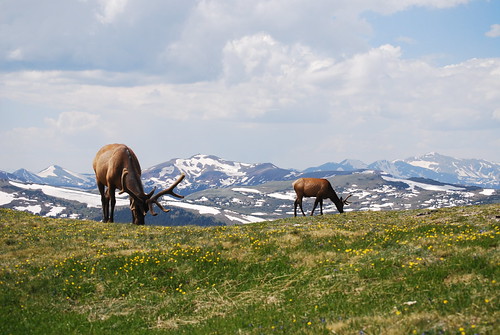
My trip out to the Rocky Mountains for my family reunion was not as productive as I had hoped for my life list, but it was still a good birding experience. I added 8 species to my ABA list and 7 to my life list: Great-tailed Grackle (ABA), Swainson’s Hawk, Violet-green Swallow, Broad-tailed Hummingbird, Band-tailed Pigeon, Sage Thrasher, Scissor-tailed Flycatcher and Upland Sandpiper. Of these, only the swallow and hummingbird were birds I saw while out birding, and not as a drive-by while traveling – although I did get better looks at Swainson’s Hawks on the 4th at Windy Gap Reservoir. The Sage Thrasher was sort of an iffy look at a rest stop as we were getting in the car but I’m about 98% certain that’s what the bird was. The Band-tailed Pigeons I saw weren’t cooperative either, as I had a very brief look at a pair flying away as we drove up the mountains on our first day, but luckily one of the species’ major diagnostic marks is best viewed on a bird flying away – the banded tail, which is what I saw on the birds. That field mark plus the habitat pretty much cinches the identification.
Violet-green Swallow - The only life bird I was able to get decent photos of!
One of the reasons I think I missed a lot of life birds, besides the fact I was doing family activities and only had an hour devoted to nothing but birding, was the fact that there was a lot of active logging of lodgepole pines at the YMCA ranch we were staying at. The logging was to remove trees killed by the pine beetle infestation, which is on track to eliminate 90% of the lodgepole pines in Grand County in two years. Considering that most of the forest in Grand County is lodgepole pine, this is a major disaster. To get an idea of the scope of the infestation, take a look at the picture of the mountain below. Normally, that mountain should look green but instead is rust-colored from all the dead trees.
Anyway, the logging at the ranch was concentrating on removing dead trees from the property as a fire prevention measure, which I am sure has driven out a lot of birds. Still, I had a lot of good birds at the ranch, including Violet-green Swallows, Red Crossbills, Mountain Bluebirds, Northern Goshawk, Spotted Sandpiper, Green-winged Teal, American Widgeon, Pine Siskin, Broad-tailed Hummingbird, and others.
"Red-shafted" Northern Flicker (note the dead pines in background)
Pine Siskin, Rocky Mountain National Park
Female Mountain Bluebird
We only spent a little time in Rocky Mountain National Park, and it wasn’t very birdy where we stopped, unfortunately. I did get some spectacular shots of some bull elk browsing at 12,000 feet, thought, and a good moose photo!
Bull Elk, Rocky Mountain National Park
Cow moose, Rocky Mountain National Park
All in all, it was a good trip, and just a taste of the birding that awaits me on future trips out there…
Tuesday, July 1, 2008
Going to Colorado for a couple of days
I went and looked at my eBird list to see what I had entered for Colorado, based on photos and memory. There are only 5 birds: Golden Eagle, Clark's Nutcracker, Black-billed Magpie, American Dipper and Mountain Bluebird (although I'm sure there's other birds on there I just didn't add, like Dark-eyed Junco which I know we saw). I should add significantly to that list this time out. In addition, my ABA list is at 388 right now (ebird says 389, but that's because they don't seem to have a good ABA filter right now - Black-hooded Parakeet isn't on the official ABA list yet). I think there's an EXCELLENT chance of hitting 400 on this trip. This is due to the fact that besides spending 2 whole days in the Colorado mountains, we had to fly into Kansas City because of airfare costs instead of flying into Denver. So we have about a 12 hour trip to and from Winter Park that will take us across the Colorado and Kansas plains, givining me a good chance at birds like Swallow-tailed Flycatcher, Say's Phoebe, Swainson's Hawk, and Ferruginous Hawk. I'll basically be plastered to the minivan window, staring out at the plains the entire time, hoping for one of these birds, as well as starting my Kansas list . . . A birder is never bored on a long car trip!
